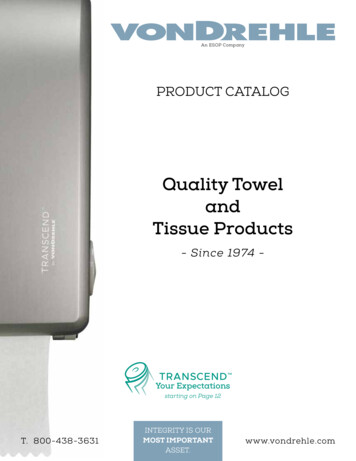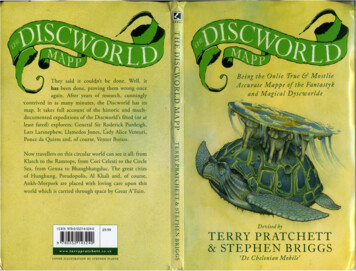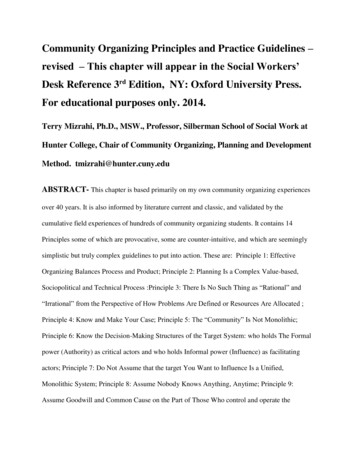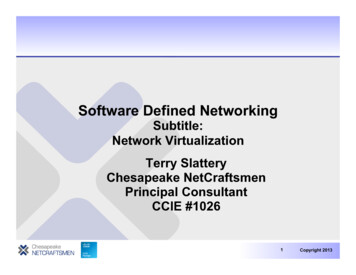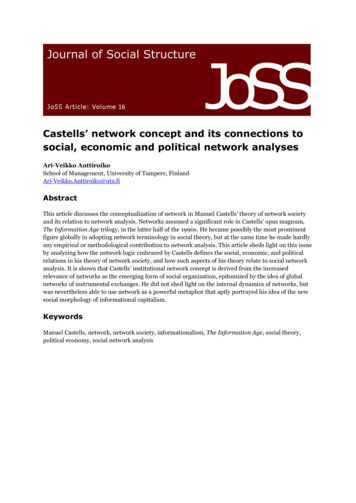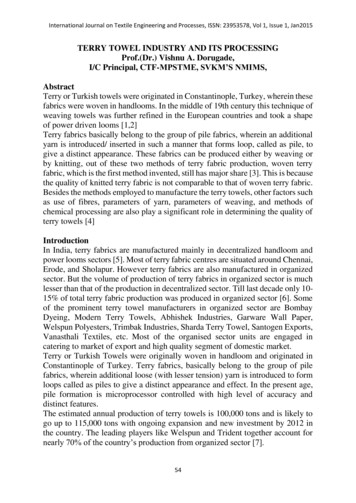
Transcription
International Journal on Textile Engineering and Processes, ISSN: 23953578, Vol 1, Issue 1, Jan2015TERRY TOWEL INDUSTRY AND ITS PROCESSINGProf.(Dr.) Vishnu A. Dorugade,I/C Principal, CTF-MPSTME, SVKM’S NMIMS,AbstractTerry or Turkish towels were originated in Constantinople, Turkey, wherein thesefabrics were woven in handlooms. In the middle of 19th century this technique ofweaving towels was further refined in the European countries and took a shapeof power driven looms [1,2]Terry fabrics basically belong to the group of pile fabrics, wherein an additionalyarn is introduced/ inserted in such a manner that forms loop, called as pile, togive a distinct appearance. These fabrics can be produced either by weaving orby knitting, out of these two methods of terry fabric production, woven terryfabric, which is the first method invented, still has major share [3]. This is becausethe quality of knitted terry fabric is not comparable to that of woven terry fabric.Besides the methods employed to manufacture the terry towels, other factors suchas use of fibres, parameters of yarn, parameters of weaving, and methods ofchemical processing are also play a significant role in determining the quality ofterry towels [4]IntroductionIn India, terry fabrics are manufactured mainly in decentralized handloom andpower looms sectors [5]. Most of terry fabric centres are situated around Chennai,Erode, and Sholapur. However terry fabrics are also manufactured in organizedsector. But the volume of production of terry fabrics in organized sector is muchlesser than that of the production in decentralized sector. Till last decade only 1015% of total terry fabric production was produced in organized sector [6]. Someof the prominent terry towel manufacturers in organized sector are BombayDyeing, Modern Terry Towels, Abhishek Industries, Garware Wall Paper,Welspun Polyesters, Trimbak Industries, Sharda Terry Towel, Santogen Exports,Vanasthali Textiles, etc. Most of the organised sector units are engaged incatering to market of export and high quality segment of domestic market.Terry or Turkish Towels were originally woven in handloom and originated inConstantinople of Turkey. Terry fabrics, basically belong to the group of pilefabrics, wherein additional loose (with lesser tension) yarn is introduced to formloops called as piles to give a distinct appearance and effect. In the present age,pile formation is microprocessor controlled with high level of accuracy anddistinct features.The estimated annual production of terry towels is 100,000 tons and is likely togo up to 115,000 tons with ongoing expansion and new investment by 2012 inthe country. The leading players like Welspun and Trident together account fornearly 70% of the country’s production from organized sector [7].54
International Journal on Textile Engineering and Processes, ISSN: 23953578, Vol 1, Issue 1, Jan2015Government InitiativesIn addition to the above, the Government announced on 7th December, 2008 and2nd January, 2009, packages of measures to stimulate the economy. So far as thetextiles sector is concerned, the measures, inter-alia, provide for the following: Additional allocation of US 533.87 million to clear the entire backlog ofTechnology Upgradation Fund Scheme (TUFS). All items of handicrafts to be included under “Vishesh Krishi & Gram UdyogYojana (VK&GUY)”. Provision of Additional funds for full refund of Terminal Excise Duty/CentralSales Tax. Enhanced back-up guarantee to EPGC to cover for exports to difficultmarkets/products. Refund of Service Tax on foreign agent commissions of upto 10% of Freighton Board (FOB) Value of exports as well as refund of service tax on output service whileavailing benefits under Duty Drawback Scheme. Credit targets of Public Sector Banks revised upward to reflect the needs ofthe economy. Guarantee cover under Credit Guarantee Scheme doubled to Rs.10 millionwith cover of 50%.THE ROAD AHEADThe Indian Textiles Industry has an overwhelming presence in the economic lifeof the country. Apart from providing one of the basic necessities of life, thetextiles industry also plays a pivotal role through its contribution to industrialoutput, employment generation, and the export earnings of the country. Currently,it contributes about 14% to industrial production, 4 percent to the GDP, and 17%to the country's export earnings. It provides direct employment to over 35 millionpeople. The Textiles sector is the second largest provider of employment afteragriculture. Thus, the growth and all round development of this industry has adirect bearing on the improvement of the economy of the nation.The government strategizes to attract foreign investments in the textile sector byinitiating trade talks with manufacturers and business groups in Switzerland, Italyand Turkey. The aim is to tap foreign capital towards establishing green fieldunits in textiles machinery, fabric and garment manufacturing and attractinginvestments in the field of technical textiles. India offers various incentives toforeign investors like low-cost labour and intellectual right protection. Thegovernment has allowed 100 per cent FDI in the textiles sector. India has avertical and horizontal integrated textiles value chain, and represents a strongpresence in the entire value chain from raw materials to finished goods.The textile ministry expects Textile Industry to more than double to 115 billionby 2012 from the current 50 billion. India's share of global textile exports is55
International Journal on Textile Engineering and Processes, ISSN: 23953578, Vol 1, Issue 1, Jan2015expected to increase from the current 4.0 per cent to around 7.0 per cent over thenext three-years. The textile ministry is also pursuing trade agreements with theUS and the European Union, which together account for almost 40 per cent of thecountry's textile exports. The government is looking at new markets in Russia,China, South East Asia, the Middle East, Japan and Latin America, under the newexport policy. India's textile exports have shot up over 15 per cent from 19.14billion in 2006-07 to 22.13 billion in 2007-08.Till last decade, Indian terry towel industry was dominated by decentralizedHandloom and Power-loom sectors of Panipat, Karur, Erode, Mumbai, Sholapur,Ahmedabad and Delhi constituting the share of over 80% of the total productionof Towel Industry. But, for the last 10 years, many of the organized sectors haveentered in this segment [9].Organized Sectors are mainly moving from mid low end to mid high end marketwhereas decentralized Sholapur, Panipat are concentrating more on low end anddomestic market. Some of the high quality power loom fabrics from decentralizedsectors are being slowly accepted in leading markets of USA and EU. Many ofthe Indian companies are also expected to enter in the World Marketpredominantly through acquisition and branding with this segment in the years tocome.Future ProspectsThe usage of towels in domestic market is constantly increasing with theexpansion of hospitality services and opening of Trade Centers and Malls. TheMarket for Terry Towel has been growing rapidly. The Indian domestic Textilesindustry is worth Rs.1,75,000 Crore. The Terry Towel Sector is zooming with thenew EXIM Policy and increase in demand from US Markets. USA is the World''ssingle largest buyer for Made-ups and Terry Towels. India, China and Pakistantogether supply 65% towels, 81% of sheets and 79% of comforters imported byUSA. While India has a dominant position in America''s terry towel import, witha share of around 26%, India''s home textile contributes around 22% i.e. US 4.1billion to India''s textile export of US 19 billion. However, the share of terrytowel is just 5.8% of total home textile export i.e. US 255 million in 2005-06and US 239 million in 2006-07, and there is a room to grow. Till recent time,marketing effort was concentrated in USA, but many are looking for othermarkets of the EU and other parts of the World. In view of this the Company isconfident of serving new markets with higher profitability on its revival.Structural Changes as far as textile industry is concerned are given in Table 1&2and represented in Graph 1.Table 1: Structural Change: Asian Dominance in Home Textiles China:36%Textiles and ClothingUS 708bn India :4% China:33%TextilesUS 286 bn India :5%56
International Journal on Textile Engineering and Processes, ISSN: 23953578, Vol 1, Issue 1, Jan2015 India, China and Pakistan:85%Table 2: Structural Change: Non-India players facing challengesChinaPakistanBangladesh Big Importer of Cotton NegligiblecottonImporterCotton Production LosingexportCompetitiveness Focus shift from Environmentaltextiles to higher value- Energycompliance issuesadded industriesissues Wage inflation Rising power costs Geopolitical Workers' Stricter environmental issuessafety issuescompliance Focus on domestic Complianceconsumptionissues Yarncapacityclosures Yuan appreciationGraph 1: Structural Changes: More Prominent in Home TextilesHome Textiles US 40 bnTERRY TOWEL PROCESSINGThe main fiber which is used in towels is cotton. As cotton fiber is not sensitiveto alkali or chlorine bleach but is to acids, all the dyeing and finishing processesmust be planned with these conditions. Like other textile materials the dyeing andfinishing stage of terry towels generally follow the workflowPRETREATMENTS OF TERRY TOWELSCotton needs a pretreatment before dyeing. Fiber preparation ordinarily involvesscouring to remove foreign material and thus ensures even access to dye liquorfrom the dye bath. This was done before the Spinning Stage, but after words we57
International Journal on Textile Engineering and Processes, ISSN: 23953578, Vol 1, Issue 1, Jan2015took the yarns and put sizing on them, this must be removed. The steps ofpretreatment are shown below: Desizing Scoring BleachingDesizing is intended to remove size from the fabric to ensure even bleaching,level dyeing and soft handle. Desizing processes differentiate according to thesizing agent used. The classical desizing process consists of removing the starchfrom towel fabric using enzymes. This desizing process simply involvesliquefying the film of size on the product. Bacterial, malt and pancreas amylasesare used as desizing agents.Enzymatic Desizing: This classical desizing process consists of removing thestarch from towel fabric using enzymes. This desizing process simply involvesliquefying the film of size on the product. Bacterial, malt and pancreas amylasesare used as desizing agents. Enzymatic desizing is the classical desizing processof degrading starch size on cotton fabrics using enzymes. Enzymes are complexorganic, soluble bio-catalysts, formed by living organisms that catalyze chemicalreaction in biological processes. Enzymes are quite specific in their action on aparticular substance. A small quantity of enzyme is able to decompose a largequantity of the substance it acts upon. Enzymes are usually named by the kind ofsubstance degraded in the reaction it catalyzes.The enzymes generally employed for desizing are:· α – amylase· β – amylase· amyloglucosidaseAmylase is the enzyme that hydrolyses and reduced the molecular weight ofamylose and amylopectin molecules in starch, rendering it water soluble enoughto be washed off the fabric. Effective enzymatic desizing requires strict controlof pH, temperature, water hardness, electrolyte addition and choice of surfactant.Enzyme sources are either from animal origin (slaughter house waste – pancreas,clotted blood, liver etc.), vegetable origin (malt extract – made from germinatedbarley), and bacterial (produced by growing cultures of certain micro organisms).Bacterial enzymes are preferred because of their activity over a wider pH rangeand tolerance to variations in pH. Since desizing is carried out on grey fabric,which is essentially non-absorbent, a wetting and penetrating agent isincorporated into the desizing liquor. Bacterial enzymes are commerciallyavailable in three grades:Effective enzymatic desizing requires strict control of pH, temperature, waterhardness, electrolyte addition and choice of surfactant. Enzyme sources are eitherfrom animal origin (slaughter house waste – pancreas, clotted blood, liver etc.),vegetable origin (malt extract – made from germinated barley), and bacterial(produced by growing cultures of certain micro organisms). Bacterial enzymesare preferred because of their activity over a wider pH range and tolerance to58
International Journal on Textile Engineering and Processes, ISSN: 23953578, Vol 1, Issue 1, Jan2015variations in pH. Since desizing is carried out on greige fabric, which isessentially non-absorbent, a wetting and penetrating agent is incorporated into thedesizing liquor.DYEING OF TERRY TOWELIt is over thirty years since reactive dyes for cellulose were introduced and theynow account for about 25% of the total dye consumption on that fibre. Thereemerged after the results of the work on the mechanisms of organic reactionswere in place and their enabled their development to be characterized by the studyand application of reaction mechanisms involved in the dye-fibre reaction. Thisfactor has paid handsome dividend. The work continues, increasingly gainingcost-effectiveness by enhancing reaction mechanisms, such as polymerization,have met with little success and the simple nucleophilic substitution and additionmechanisms of dye fixation remain totally dominant.The following factors rightly justify the usage of reactive dyes world wideBright shadesGood Fastness propertiesEasy applicationModerate costEco-friendlinessBright shades: The reactive dyes are the brightest dyes available for thecellulosic fibres and have a full range of shades.Good Fastness properties: Colour Fastness may be defined as”the resistance ofa material to change in any of its color characteristics, to transfer its colorant(s)to adjacent materials, or both, as a result of the exposure
Enzymatic Desizing: This classical desizing process consists of removing the starch from towel fabric using enzymes. This desizing process simply involves
